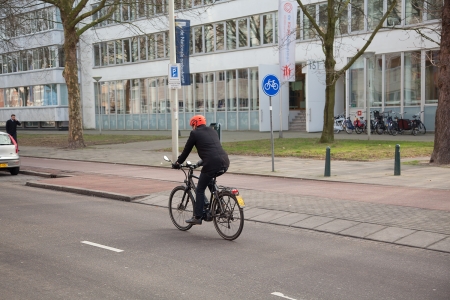Measures specifically aimed at the safety of speed pedelec riders particularly relate to the reduction of speed differences, helmet use, improving expectations of other road users, and preventing registration number fraud. In addition, it is advisable to properly research what position on the road is safest for speed pedelecs. Finally, safety measures focusing on a safe infrastructure for cyclists will also benefit the safety of speed pedelec riders (see SWOV fact sheet Cyclists).
Reducing speed differences
There are considerable speed differences between speed pedelecs and other road users on the combined bicycle/moped track and presumably (empirical data are missing) also between speed pedelecs and motorised four-wheelers on 50km/h roads (see the question How fast do pedelec and speed pedelec riders cycle?). In general, speed differences have a negative effect on road safety (see SWOV fact sheet Speed and speed management). These speed differences can be reduced if, within the urban area, a speed limit of 30 km/h becomes more usual. Another option is to allow speed pedelecs to use the bicycle track at some locations, but only if they cycle at a speed which is better aligned with the speed of the other users of the bicycle track. In Rotterdam, for instance, speed pedelecs have been granted an exemption from the prohibition to use the bicycle track, provided they do not cycle faster than 30km/h. In the urban area, however, this limit is still (over) 10 km/h faster than the speed at which bicycle and pedelec riders cycle. To ensure the safety of cyclists on the bicycle track, the speed limit should really be lower. Naturally, this limit should then be enforced. An innovative way to make speed pedelec riders keep to the maximum speed, is geofencing. This will restrict motor assistance when the speed pedelec starts cycling on the bicycle track as determined by the GPS. At present, the technology is not sufficiently precise to make distinctions between the carriageway and the combined moped/bicycle track. Moreover, geofencing is only able to restrict pedal assistance, but not cycling speed itself. Speed pedelec riders may – just as sports cyclists – use more effort to still reach higher speeds [51].
Another method to reduce speed differences, is increasing the speed of speed pedelecs, so they can follow the speed of cars on 50 km/h roads. It is unclear what the net effect on road safety would be.
Helmet use
Helmets are mandatory for speed pedelec riders, be it a moped helmet or a special speed pedelec helmet (see the question What rules apply to pedelecs and speed pedelecs?). However, it turns out that by no means all speed pedelec riders wear the correct helmet [29]. Public communication about the importance of wearing the correct helmet, together with enforcement, could improve helmet choice.
Improving expectations of other road users
A speed pedelec is a relatively new and, as yet, uncommon vehicle. In appearance, it resembles a bicycle or pedelec, but it is subject to different traffic rules. Public communication about speed pedelecs and the associated rules will provide other road users with information about what to expect of this road user group. This may reinforce understanding of speed pedelecs on the carriageway, which could lead to fewer expressions of irritation among motorised road users (see the question What position on the road is safest for speed pedelecs?). An increase in the number of speed pedelecs in traffic may also be helpful.
Prevention of registration plate fraud
Some speed pedelec riders remove their registration plate, so they are seen as ordinary pedelec riders and, thus, do not need to wear a helmet and may cycle on the bicycle track (see the question What rules apply to pedelecs and speed pedelecs?). If this does not go hand in hand with a lower speed, not only the safety of the speed pedelec riders themselves but also that of other road users on the bicycle track will be negatively affected. Enforcement should help reduce registration plate fraud. Information about the consequences regarding statutory liability may be helpful.
Safest position on the road
It is still unclear what position on the road is safest for speed pedelecs, the carriageway or the bicycle track. In the urban area, speed pedelec riders are, like mopeds, legally obliged to use the carriageway, unless a combined bicycle/moped track is present (see the question What rules apply to pedelecs and speed pedelecs?). In the case of mopeds, this proved to be safer than using the bicycle track [52]. For both these positions on the road, there are still insuffient data on crash involvement in relation to exposure to determine whether this also goes for speed pedelecs. What we do know is that speed pedelec riders do not always feel safe among the cars on the carriageway. To allow speed pedelec riders to use (certain) bicycle tracks, some road authorities derogate from national regulations, for example by putting a ‘Speed pedelecs allowed’ plate below the bicycle track sign, or by offering a municipal exemption (as was done in Rotterdam). With that exemption, use of the bicycle track is allowed provided that speed pedelecs do not cycle faster than 30 km/h and do not endanger other bicycle track users. Yet, the 30 km/h limit is still higher than the average speed cycled on conventional bicycles and pedelecs. Moreover, local derogations from national traffic regulations will make the traffic system less predictable and may therefore reduce safety.
